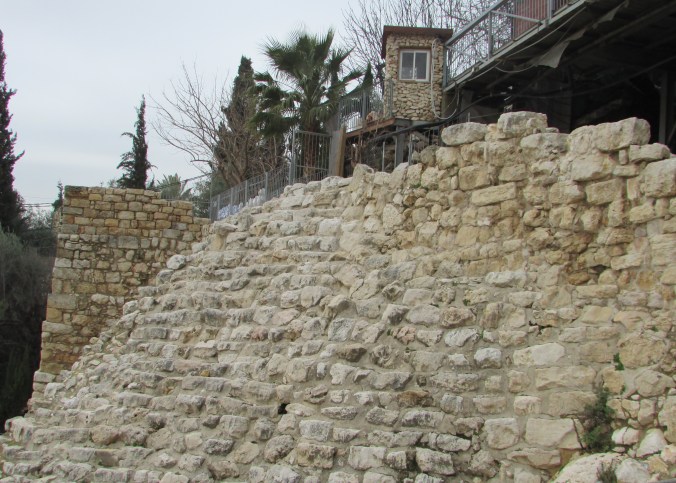Are you tired of reading about archaeological ruins yet? Israel is truly an archeologist’s dream and Jerusalem is no exception. I must admit that by the second last day of our tour, I was beginning to experience information overload. That, combined with the fact that we were hurrying to stay ahead of a huge group of Taiwanese tourists when we visited the City of David, meant that I probably missed a few things, but there are some that stand out vividly in my memory. Located beneath the Arab neighbourhood of Wadi Hilweh and below the southern walls of Old Jerusalem, the City of David is the archaeological site of ancient Jerusalem of the pre-Babylonian exile era.
What stood out to me most was a section of wall from three different eras!

Originally built by the Jebusites, a Canaanite tribe who built and inhabited Jerusalem prior to its conquest by King David, the tower to the left was added in David’s time. What interested me most was the upper right hand section of the wall where the stones are of slightly different size and colour. This is a section of the wall that was repaired under the direction of Nehemiah after the Jews returned from exile in Babylon. (Nehemiah 2-6)
Our local church here in Sedgewick is in the middle of a three year rebuilding project of our own. Over the years, we’d gradually let the church building and parsonage slip into disrepair. Our pastor used the story from Nehemiah to introduce the project and the accompanying need for extra funds to the congregation, so we chose to call it our Nehemiah Project. It gave me shivers to stand there and see with my own eyes a small portion of the original Nehemiah project!
Looking across the valley to the bottom of the hill below the Arab village, we could see the entrances to ancient Jewish tombs with garbage scattered all around. It’s very easy to distinguish between Arab and Jewish communities in Israel. Jewish neighbourhoods and settlements are clean, orderly and prosperous looking while Arab ones are shabby and unkempt.

Before leaving the City of David, we entered Warren’s Shaft which enabled the ancient Canaanite residents to draw fresh water from the Gihon Spring without leaving the city. Hezekiah’s Tunnel was later built under the direction of King Hezekiah to bring fresh water from the spring into Jerusalem. (2 Kings 20:20)
While we toured the City of David, we could hear the Arabs shouting at us, but since we couldn’t understand what they were saying, we paid them no mind. When we exited the water shaft, we had only a few hundred metres to go down a narrow street to what remains of the Pool of Siloam. Some tour groups were using shuttle vans for fear of being stoned, but we walked the distance briskly without any incident.


It was at the Pool of Siloam that Jesus healed a blind man by putting mud on his eyes and telling him to wash in the pool. (John 9:1-12) Only a portion of it has been excavated. The remainder is under property owned by a Palestinian family who refuse to relinquish it.

From the pool, we walked up another section of the Herodian road that we’d been on in the Western Wall tunnels the evening before, again walking on stones that our Lord undoubtably walked upon. This was the route used in His day to ascend from the Pool of Siloam to the Temple Mount.

Next we made our way through the ancient city’s recently excavated central drainage tunnel which connects the west side of the Temple Mount to the Pool of Siloam area. Traversing the lengthy tunnel was definitely a “team building” experience as each of us called back to the ones behind us warning of slippery spots and low ceilings!
After further examining portions of the Western Wall, we had hoped to go to the southern steps, an enormous flight of stairs leading up to the Southern Wall, but the Muslim mosque above the area was in use and we couldn’t enter. Apparently, there have been incidents of people being stoned from above, so the area is closed when the mosque is in use!



Elaine
Enjoying your blogs and will likely print them to use as my own recollection of the trip. I am going to use pictures from everybody to try to make a video to remember the trip by.
Thank you, Gilles! We’d love to see your video if that’s possible.
I’ve been enjoying posts of your trip to Palestine! I love the interesting facts and fascinating pictures that you include!
Thank you, Geetanjali!